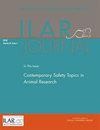Nontraditional Laboratory Animal Species (Cephalopods, Fish, Amphibians, Reptiles, and Birds).
IF 3.1
3区 农林科学
Q1 VETERINARY SCIENCES
引用次数: 2
Abstract
Aquatic vertebrates and cephalopods, amphibians, reptiles, and birds offer unique safety and occupational health challenges for laboratory animal personnel. This paper discusses environmental, handling, and zoonotic concerns associated with these species.
非传统实验动物种类(头足类、鱼类、两栖类、爬行类和鸟类)。
水生脊椎动物和头足类动物、两栖动物、爬行动物和鸟类为实验动物人员提供了独特的安全和职业健康挑战。本文讨论了与这些物种有关的环境、处理和人畜共患问题。
本文章由计算机程序翻译,如有差异,请以英文原文为准。
求助全文
约1分钟内获得全文
求助全文
来源期刊

Ilar Journal
农林科学-兽医学
CiteScore
5.10
自引率
20.00%
发文量
8
审稿时长
>18 weeks
期刊介绍:
The ILAR Journal is the peer-reviewed, theme-oriented publication of the Institute for Laboratory Animal Research (ILAR), which provides timely information for all who study, use, care for, and oversee the use of animals in research. The journal publishes original articles that review research on animals either as direct subjects or as surrogates for humans. According to policy, any previously unpublished animal research reported in the ILAR Journal will have been conducted according to the scientific, technical, and humanely appropriate guidelines current at the time the research was conducted in accordance with the Guide for the Care and Use of Laboratory Animals or other guidance provided by taxonomically-oriented professional societies (e.g., American Society of Mammalogy) as referenced in the Guide.
 求助内容:
求助内容: 应助结果提醒方式:
应助结果提醒方式:


